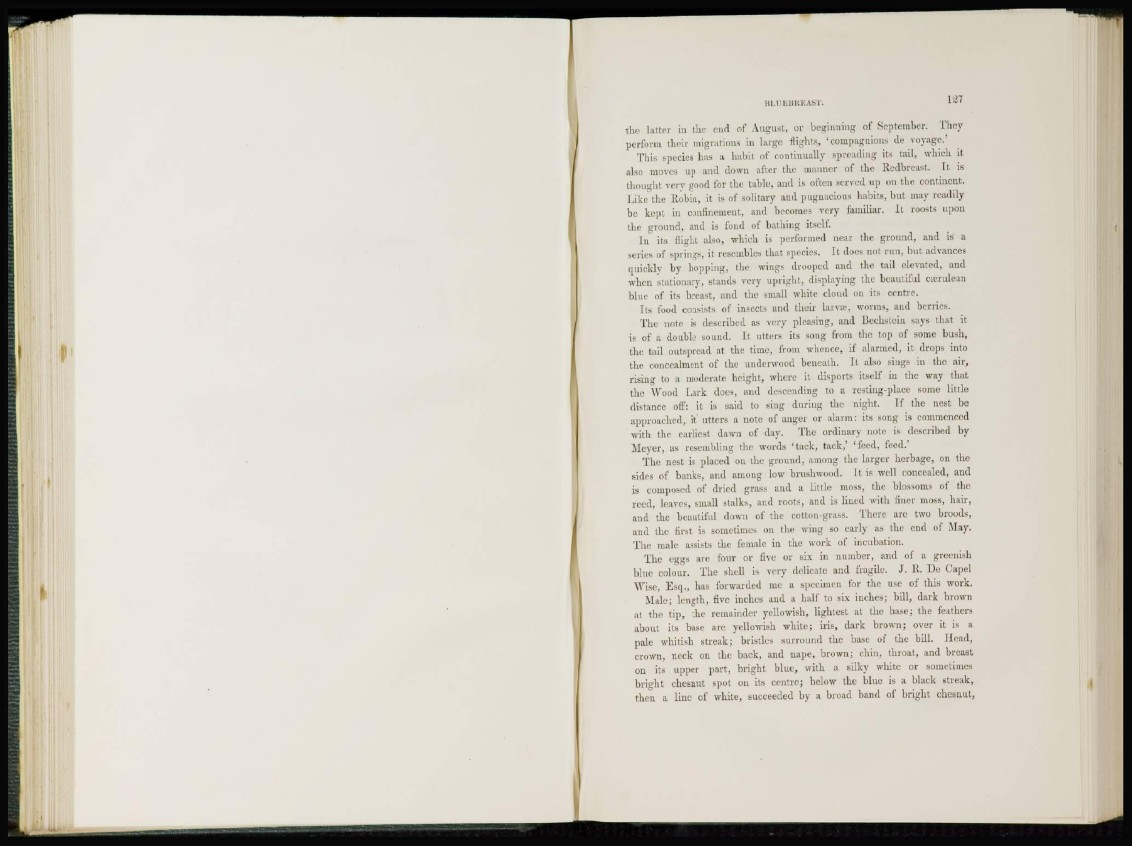
BLUES RE AST.
the latter in the end of August, or beginning of September. They
perforin their migrations in large flights, ' compagnions de voyage.*
This species has a habit of continually spreading its tail, which it
also moves up and down after the manner of the Redbreast. It is
thought very good for the table, and is often served up on the continent.
Like the Robin, it is of solitary and pugnacious habits, but may readily
be kept in confinement, and becomes very familiar. It roosts upon
the ground, and is fond of bathing itself.
In its flight also, which is performed near the ground, and is a
scries of springs, it resembles that species. It docs not run, but advances
quickly by hopping, the wings drooped and the tail elevated, and
when stationary, stands very upright, displaying the beautiful CEerulean
blue of its breast, and the small white cloud on its centre.
Its food consists of insects and their larva', worms, and berries.
The note is described as very pleasing, and Bechstein says that, it
is of a double sound. It utters its song from the top of some bush,
the tail outspread at the time, from whence, if alarmed, it drops into
the concealment of the underwood beneath. It also sings in the air,
rising to a moderate height, where it disports itself in the way that
the Wood Lark does, and descending to a resting-place some little
distance off: it is said to sing during the night. If the nest be
approached, it utters a note of anger or alarm: its song is commenced
with the earliest dawn of day. The ordinary note is described by
Mever, as resembling the words 'tack, tack,' 'feed, feed.'
The nest is placed on the ground, among the larger herbage, on the
sides of banks, and among low brushwood. It is well concealed, and
is composed of dried grass and a little moss, the blossoms of the
reed, leaves, small stalks, and roots, and is lined with finer moss, hair,
and the beautiful down of the cotton-grass. There are two broods,
and the first is sometimes on the wing so early as the end of May.
The male assists the female in the work of incubation.
The eggs are four or five or six in number, and of a greenish
blue colour. The shell is very delicate and fragile. J. R. De Capel
Wise, Esq., has forwarded me a specimen for the use of this work.
Male; length, five inches and a half to six inches; bill, dark brown
at the tip, the remainder yellowish, lightest at the base; the feathers
about its base are yellowish white; iris, dark brown; over it is a
pale whitish streak; bristles surround the base of the bill. Head,
crown, neck on the back, and nape, brown; chin, throat, and breast
on its upper part, bright blue, with a silky white or sometimes
bright chesnut spot on its centre; below the blue is a black streak,
then a line of white, succeeded by a broad band of bright chesnut,